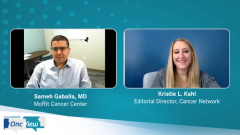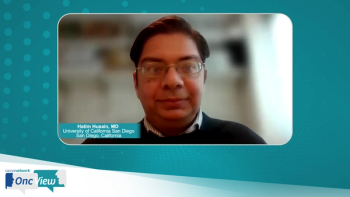
Unmet Needs and Looking Ahead in Follicular Lymphoma
Sameh Gaballa, MD, focuses on unmet needs and the future of the treatment landscape for follicular lymphoma.
Episodes in this series

Kristie L. Kahl: Lastly, I want to talk about unmet needs in follicular lymphoma beyond the second-line setting. To start, what are the unmet needs in patients who have relapsed and refractory follicular lymphoma?
Sameh Gaballa, MD: Obviously, the biggest unmet need is POD24, those who are progressing with 24 months of chemo-immunotherapy. Their survival is lower than the rest of the patients. It would be great if we have better tools to risk stratify and identify these patients early on. Obviously, we have the FLIPI [Follicular Lymphoma International Prognostic Index] score, but it doesn’t identify all these high-risk patients. This is the group of patients that is really a great unmet need, and this is where CAR [chimeric antigen receptor] T-cell therapy might have the biggest impact.
The other area of improvement is chemotherapy-free regimen. We have the R2 [lenalidomide, rituximab] trial in the first line. The RELEVANCE trial was designed as a superiority trial, not a noninferiority trial. Looking at the overall responses and the PFS [progression-free survival], it’s a very reasonable option in the first-line setting as well. But we definitely need more of these chemotherapy-free regimens in the first and second lines. Try to get away from the chemo-immunotherapy, which does have toxicities, particularly in older patients.
Kristie L. Kahl: What does the treatment landscape look like going forward?
Sameh Gaballa, MD: CAR T is definitely going to have a very good impact. There are probably going to be studies in the future to look at its earlier role in these high-risk groups of patients, so maybe a trial and POD24 would make sense. This is the biggest unmet need right now. The other thing is moving some of the approved regimens in the third line to the earlier lines of therapy, or combining them with other agents, like PI3 kinase inhibitors.
We have some studies in the earlier lines. We may possibly see tazemetostat [Tazverik] in the earlier lines. There’s an ongoing study combining tazemetostat with R2 [lenalidomide, rituximab]. It’s a randomized trial: R2 [lenalidomide, rituximab] vs tazemetostat plus R2 [lenalidomide, rituximab]. It will be interesting in the long run to see how that will turn out. Hopefully, in the not-so-distant future, some of these agents may be incorporated, even in the first-line setting. There are obviously a lot of investigational agents around. Fasinumab [REGN475] is an interesting agent. It’s an anti-CD19, and it probably will have a role in follicular lymphoma. There are ongoing clinical trials with the fasinumab and follicular, but this will hopefully be an addition to the available options.
Kristie L. Kahl: Thank you so much.
Sameh Gaballa, MD: You’re welcome. Thank you.
Kristie L. Kahl: Thank you. I hope you all found this information to be valuable to your clinical practice. Thank you for watching CancerNetwork®’s OncView program from MJH Studios™.
Transcript edited for clarity.
Newsletter
Stay up to date on recent advances in the multidisciplinary approach to cancer.



















































































